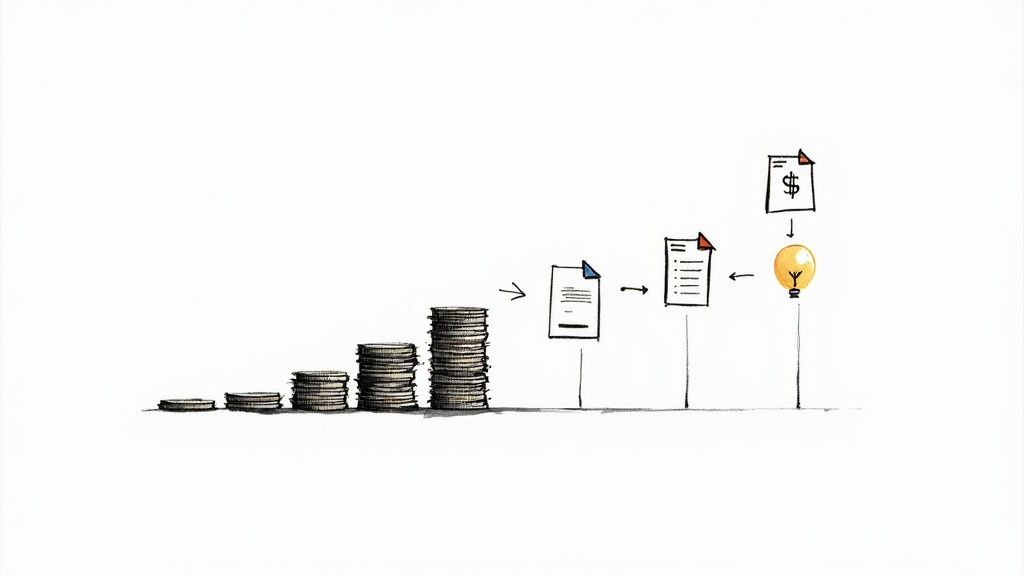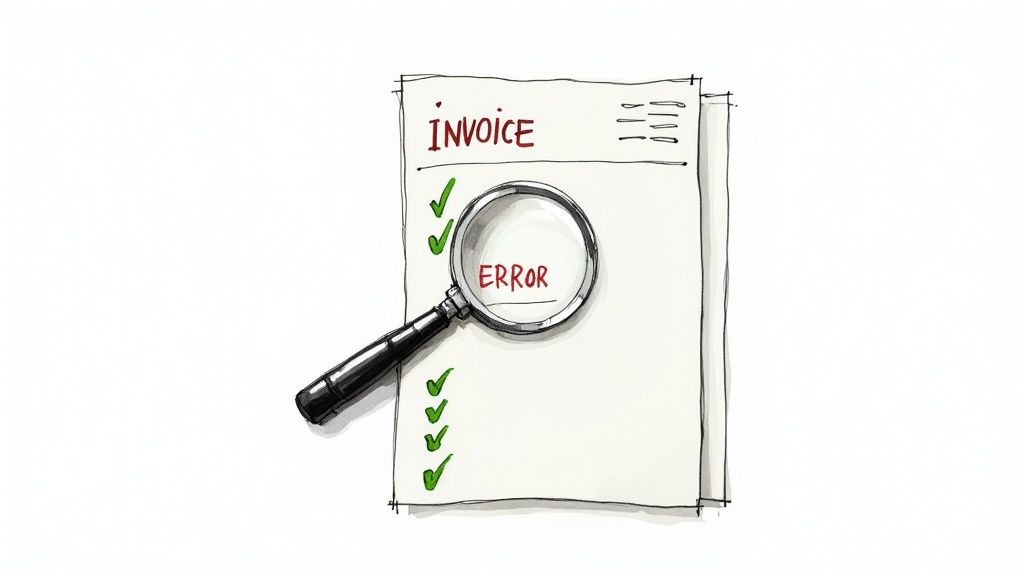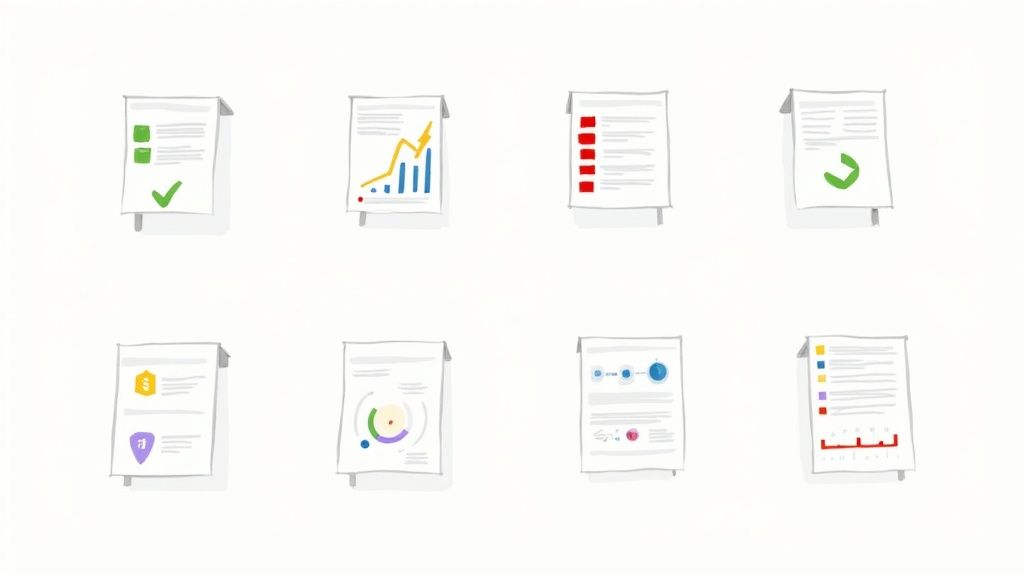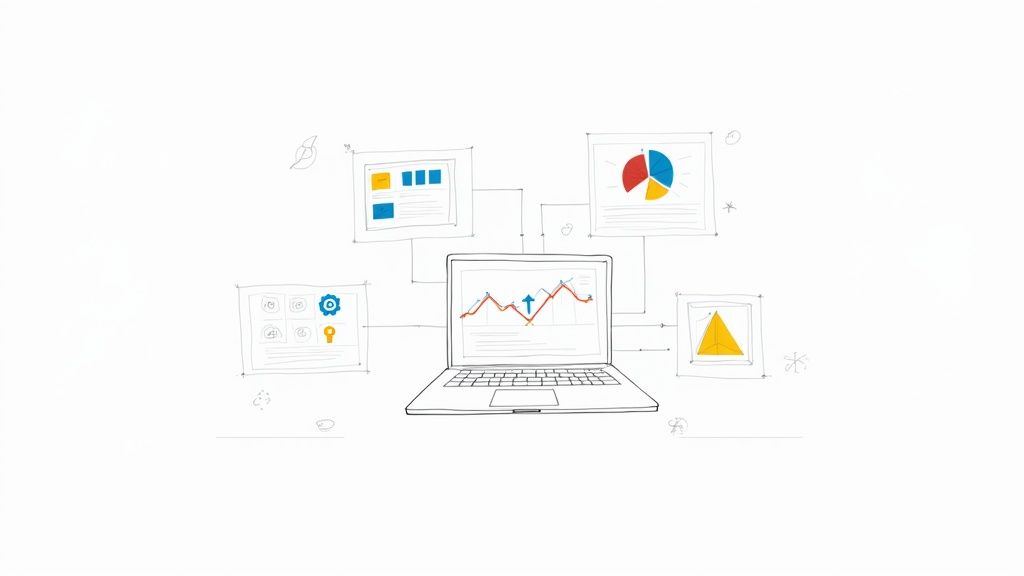
In today's fast-paced business environment, manual invoice processing is a significant drag on resources. It introduces costly errors, delays payments, and ultimately hinders growth. While many businesses stick to what they know-spreadsheets, emails, and paper trails-they are unknowingly sacrificing efficiency, accuracy, and strategic financial control. The shift from manual to automated systems is no longer a luxury reserved for large corporations; it's a critical step for businesses of all sizes looking to thrive in a competitive market.
This article moves beyond abstract concepts to deliver concrete, actionable insights into the transformative power of invoice automation. We will detail eight key invoice automation benefits, providing practical examples of how modern tools can revolutionize your accounts payable workflow. You will learn how integrating automation with platforms you already use, like Airtable, ClickUp, or Zapier, can help you reclaim valuable time and slash operational costs. Prepare to see how you can gain a real-time financial overview that empowers smarter, data-driven business decisions and strengthens your bottom line.
1. Benefit #1: Slash Processing Time and Boost Team Efficiency
One of the most immediate and impactful invoice automation benefits is the dramatic reduction in manual processing time. Traditional invoicing is a labor-intensive gauntlet of data entry, purchase order cross-referencing, and routing for approvals, a process that can stretch from days to weeks. This manual grind doesn't just slow down payments; it consumes valuable employee hours that could be dedicated to more strategic financial analysis.

Automated systems completely transform this timeline, collapsing it into mere hours or even minutes. They operate 24/7, leveraging technologies like Optical Character Recognition (OCR) and AI to instantly extract data from various invoice formats. The system then automatically matches this information to purchase orders and routes it through predefined approval workflows without creating human bottlenecks. Furthermore, automating invoices often incorporates advancements like understanding the legal value of digital signatures, which can further accelerate approvals and enhance security. This frees your team from tedious administrative tasks to focus on high-value activities.
Real-World Impact
Consider how Siemens reduced its average invoice processing time from a lengthy 20 days down to just 3 days after implementing automation. Similarly, Coca-Cola European Partners achieved an impressive 85% touchless invoice processing rate, demonstrating that the vast majority of their invoices require zero human intervention from receipt to payment.
Practical Example: A digital marketing agency uses ClickUp to manage client projects. When a task is moved to the "Project Complete" status, a Zapier automation is triggered. Zapier sends the project details (client name, services rendered, total cost) to DocsAutomator, which instantly generates a branded PDF invoice and emails it to the client. This entire sequence, which used to take hours of manual work, is completed in under a minute.
How to Implement This Benefit
- Start Small and Scale: Begin by identifying your highest-volume, most standardized invoices, typically from your top vendors or for recurring services. This provides a quick win and a clear proof of concept.
- Define Clear Workflows: Establish role-based approval thresholds directly within the automation software. For instance, invoices under $500 are automatically approved, while those over $5,000 require senior management sign-off.
- Monitor and Optimize: Regularly track key metrics like 'average processing time per invoice' and 'touchless processing rate' to identify and resolve new bottlenecks. This is a core tenet of effective business process optimization techniques.
- Handle Exceptions: Create a clear Standard Operating Procedure (SOP) for managing exceptions flagged by the system, ensuring a human can quickly resolve any discrepancies without disrupting the entire flow.
2. Significant Cost Reduction
Beyond improving efficiency, one of the most compelling invoice automation benefits is the direct and substantial reduction in operational costs. Manual invoice processing is surprisingly expensive, with studies showing the cost per invoice ranging from $15 to $40 when factoring in labor, paper, printing, postage, and physical storage. This financial drain is compounded by the high cost of correcting human errors, which are inevitable in any manual system.

Automation flips this economic equation by digitizing the entire workflow. It eliminates the need for physical materials like paper and ink and significantly cuts down on labor costs by handling the most time-consuming tasks. The cost per invoice plummets, often to between $2 and $5, freeing up significant capital. This financial relief allows businesses to reallocate funds toward growth initiatives, innovation, or improving the bottom line instead of covering administrative overhead.
Real-World Impact
The financial gains are well-documented across industries. Research from the Aberdeen Group revealed that top-performing companies using automation slashed their average cost per invoice from $23.30 down to an incredible $3.50. On a larger scale, Nestlé reported saving an estimated $1.2 million annually after automating its accounts payable processes. Similarly, the City of Phoenix reduced its processing costs by 60% and completely eliminated $180,000 in yearly paper-related expenses.
Practical Example: A small e-commerce business manages its orders in an Airtable base. When an order's status is updated to "Shipped," an Airtable automation triggers a webhook. This webhook sends the order data (customer info, items, total price) to DocsAutomator via its API. The tool generates a finalized invoice and stores it in a designated cloud folder, eliminating all costs associated with paper, printing, and manual labor for every sale.
How to Implement This Benefit
- Calculate Your ROI: When building a business case, go beyond hard costs. Factor in "soft costs" like the value of employee time saved and the potential revenue from early payment discounts, which automation makes easier to capture.
- Opt for Cloud Solutions: Choose a cloud-based invoice automation platform to avoid the high upfront costs and ongoing maintenance of on-premise IT infrastructure.
- Track Cost-Saving Metrics: Don't just "set it and forget it." Create a simple dashboard to monitor key metrics monthly, such as 'cost per invoice' and 'paper-related savings,' to quantify the ongoing financial impact.
- Start with High-Cost Vendors: Analyze your current process to identify vendors whose invoices are the most complex or error-prone to process manually. Automating these first will deliver the most significant initial cost reductions.
3. Enhanced Accuracy and Error Reduction
Manual invoice processing is inherently prone to human error. Mistakes in data entry, incorrect calculations, or misinterpretations of line items can lead to costly consequences like overpayments, duplicate payments, and strained vendor relationships. One of the most critical invoice automation benefits is the systematic elimination of these manual errors, ensuring financial data integrity from the moment an invoice is received.

Automation platforms use sophisticated Optical Character Recognition (OCR) and AI to achieve data extraction accuracy rates between 95-99%. The system reads and digitizes invoice data, then cross-validates it against purchase orders, contracts, and internal databases in real-time. Automated validation rules immediately flag discrepancies, such as a price mismatch or an invalid PO number, preventing incorrect data from ever entering your accounting system. This proactive error-checking safeguards your bottom line and maintains clean, reliable financial records. To dive deeper into the tools that make this possible, explore the landscape of invoice automation software and find the right fit for your business.
Real-World Impact
Major corporations provide powerful proof of this benefit. Johnson & Johnson, for instance, cut its invoice processing errors by a staggering 85% after implementing automation. Similarly, global shipping leader Maersk now boasts a 98% accuracy rate in its automated invoice handling.
Practical Example: A consulting firm uses SmartSuite to manage client engagements. When a project milestone is marked "Client Approved," an automation pulls the client ID, project code, and agreed fee from the SmartSuite record. It then triggers DocsAutomator to generate the invoice. This completely removes the risk of a consultant manually typing the wrong billing amount or misspelling a client name, ensuring the invoice is 100% accurate and preventing payment disputes.
How to Implement This Benefit
- Implement Vendor Standardization: Encourage key vendors to use standardized invoice templates or submit invoices via a dedicated portal. This consistency dramatically improves OCR accuracy.
- Set Up Comprehensive Validation Rules: Configure your system to automatically check for duplicate invoice numbers, match totals to POs within a set tolerance (e.g., +/- 1%), and verify vendor details against your master file.
- Regularly Update Training Data: For AI-powered systems, periodically review and correct any misinterpretations flagged by the software. This "trains" the AI to become more accurate over time with your specific invoice formats.
- Monitor Accuracy Metrics: Track the 'error exception rate' and 'first-pass accuracy rate.' A rising exception rate may signal a need to adjust validation rules or retrain the OCR model for a new vendor's invoice layout.
4. Better Cash Flow Management
One of the most strategic invoice automation benefits is gaining granular control over your company's cash flow. Manual processes create a fog of financial uncertainty, where payment due dates are managed in spreadsheets and the true status of liabilities is often unclear until it's too late. This lack of real-time visibility makes it difficult to forecast cash needs, capitalize on financial opportunities, and avoid costly penalties.

Invoice automation provides a clear, real-time dashboard of your accounts payable landscape. By digitizing and centralizing all incoming invoices, you know exactly what you owe, to whom, and when. This allows you to strategically time payments to preserve working capital or, conversely, to take advantage of early payment discounts that directly boost your bottom line. Platforms like SAP Ariba and Oracle NetSuite provide sophisticated analytics that turn your payables data into a powerful forecasting tool for informed financial decision-making.
Real-World Impact
The impact on working capital can be immense. For instance, General Electric optimized its working capital by an estimated $1.2 billion through more strategic payables management facilitated by automation. Similarly, Unilever successfully increased its capture of early payment discounts by 40%, turning a cost center into a source of savings. BMW also leveraged this visibility to improve its cash flow forecasting accuracy by a significant 30%.
Practical Example: A B2B service company uses a Glide app for its internal operations, which is powered by an Airtable backend. When a new vendor invoice is entered into the Glide app, an automation logs the amount, due date, and any early payment discount terms into their Airtable base. This data feeds a dashboard that visualizes daily, weekly, and monthly cash outflow requirements, enabling the finance manager to make strategic payment decisions directly from their app.
How to Implement This Benefit
- Implement Dynamic Discounting: Configure your system to automatically identify and flag invoices with early payment discount terms. Set up notifications to alert the finance team when a discount window is about to close.
- Establish Payment Calendars: Use the data from your automated system to create a payment schedule based on cash availability. Plan to hold onto cash as long as possible without incurring penalties, or pay early when it's most advantageous.
- Leverage Predictive Analytics: Use the reporting features within your software to forecast future cash requirements based on historical payment cycles and invoice volumes. This helps prevent cash crunches during peak periods.
- Integrate with Your ERP: Connect your invoice automation platform directly to your ERP or accounting system (like Microsoft Dynamics or Workday) for a single, unified view of your financial health, ensuring all decisions are based on complete and accurate data.
5. Improved Compliance and Audit Trail
Maintaining regulatory compliance and preparing for audits are often seen as necessary evils, draining resources and inducing stress. A key invoice automation benefit is its ability to transform this burden into a streamlined, transparent process. Manual systems are prone to lost documents, missing approvals, and fragmented records, making audit preparation a nightmare and exposing the business to compliance risks.
Automated invoice systems create an immutable, chronological record for every transaction. From the moment an invoice is received, every action, timestamp, approval, and modification is logged automatically. This creates a comprehensive digital audit trail that is easily searchable and retrievable. Instead of digging through filing cabinets or disparate email chains, auditors can be given controlled access to a centralized system that proves compliance with regulations like Sarbanes-Oxley (SOX), GDPR, and specific tax laws.
Real-World Impact
Global firms leverage this for significant gains. PwC, for instance, managed to cut its audit preparation time by an astounding 50% by utilizing the complete digital trails provided by its automated systems. Similarly, Deutsche Bank significantly enhanced its SOX compliance posture by ensuring every financial transaction had a complete, verifiable audit log. On a public sector level, an NHS Trust in the UK achieved 100% invoice traceability, a critical requirement for regulatory oversight and funding accountability.
Practical Example: A software company uses Noloco to build its client portal, with data stored in Airtable. When an invoice is generated via an automation, a record is created in an "Audit Trail" table in Airtable. This record logs the user who triggered the action, a timestamp, the data used for the invoice, and a link to the final PDF document. During a tax audit, the accountant can simply be given read-only access to this table, providing a clear, chronological history of every invoice sent. Proper automation is a core component of a sound strategy for document lifecycle management, ensuring records are handled correctly from creation to archival.
How to Implement This Benefit
- Configure Access Controls: From day one, establish strict role-based user access controls. Ensure that only authorized personnel can approve invoices or modify vendor data to maintain the integrity of the audit trail.
- Establish Retention Policies: Use the system to enforce your document retention policies automatically. Configure rules to archive or purge invoices according to legal requirements, preventing both premature deletion and unnecessary storage.
- Automate Backups: Implement an automated backup and disaster recovery plan for your invoice data. This ensures business continuity and protects your critical compliance records from loss.
- Conduct Internal Audits: Periodically perform internal audits of your automated system. Test the audit trail functionality and review access logs to ensure the system is operating as intended and remains compliant with all relevant regulations.
6. Enhanced Vendor Relationships
Beyond internal efficiencies, one of the most significant invoice automation benefits is the cultivation of stronger, more reliable vendor relationships. Manual invoicing processes are often a source of friction, characterized by late payments, lost invoices, and a frustrating lack of transparency. This uncertainty can strain partnerships and lead to vendors offering less favorable terms or prioritizing other clients.
Automated systems transform this dynamic by creating a predictable and transparent payment ecosystem. When an invoice is received, it's immediately logged and tracked, giving vendors real-time visibility into its status, from receipt to approval to scheduled payment. This reliability fosters trust and positions your company as a preferred partner, which can translate into better service, priority support, and more favorable negotiation leverage in the future.
Real-World Impact
Major corporations have demonstrated the direct link between payment automation and vendor satisfaction. For instance, Walmart improved vendor satisfaction by 35% after implementing an automated invoice processing system that provided clarity and promptness. Similarly, Tesla successfully reduced vendor payment inquiries by a remarkable 80%, freeing up both their and their vendors' accounts payable teams. Amazon's highly sophisticated system, a benchmark in the industry, has achieved 99% on-time vendor payments through extensive automation, solidifying its supply chain foundation.
Practical Example: A construction company uses an Airtable form as a portal for its subcontractors to submit invoices. When an invoice is submitted, an automation instantly sends a confirmation email, logs the invoice in their system, and updates a "Status" field visible to the subcontractor in a shared view. This transparency eliminates the need for constant "Have you received my invoice?" follow-up calls and builds trust through clear communication.
How to Implement This Benefit
- Provide Comprehensive Onboarding: When you introduce a new system, offer vendors clear instructions, video tutorials, or even a dedicated support contact to ensure a smooth transition. A seamless onboarding experience is the first step toward a better relationship.
- Offer Multiple Submission Channels: Accommodate different vendor capabilities by allowing invoice submissions through various channels, such as a supplier portal (like those offered by Coupa or SAP Ariba), email, or even direct API integration for tech-savvy partners.
- Implement a Vendor Portal: A self-service vendor portal is one of the most effective tools. It allows suppliers to check invoice statuses, update their information, and communicate directly, reducing administrative burdens on both sides.
- Establish Clear Communication Protocols: Use the automation system to send out regular status updates. For example, configure automated emails to confirm invoice receipt, notify of approval, and announce scheduled payment dates.
7. Benefit #7: Achieve Effortless Scalability and Volume Handling
As a business grows, its transaction volume inevitably increases, creating a significant challenge for traditional accounts payable departments. Manual invoicing processes simply cannot scale efficiently; handling a tenfold increase in invoices often requires a nearly tenfold increase in AP staff and resources. This direct relationship between growth and overhead creates a major operational bottleneck, stifling expansion.
One of the most strategic invoice automation benefits is the ability to decouple business growth from administrative costs. Automated systems are built for scale. They can process a surge in invoice volume, whether from a seasonal peak or rapid business expansion, without a corresponding increase in manual labor or processing time. This ensures your back-office operations can support, rather than hinder, your company's growth trajectory.
Real-World Impact
Global giants provide a clear blueprint for this scalability. Amazon processes millions of invoices daily, a feat achievable only through highly sophisticated, automated systems that manage the entire procure-to-pay cycle. Similarly, Walmart successfully scaled its AP operations from handling 100,000 invoices to over a million annually without expanding its AP team, attributing the success to its investment in automation.
Practical Example: A fast-growing SaaS company uses Stripe for billing and Airtable as their CRM. As their customer base scales from 100 to 10,000, manually creating custom invoices becomes impossible. They use Zapier to create a workflow: when a new Stripe subscription is successfully paid, Zapier pulls the customer's company details from Airtable and sends this combined data to DocsAutomator. An enterprise-grade, branded invoice is generated and emailed instantly, allowing them to handle exponential growth without hiring a dedicated billing team.
How to Implement This Benefit
- Choose Cloud-Native Solutions: Opt for cloud-based AP automation software. These platforms offer virtually unlimited capacity and are designed to handle fluctuating loads without requiring you to manage server infrastructure.
- Plan for Peak Periods: Analyze your business cycles to anticipate high-volume periods, such as year-end or post-holiday sales. Configure your system's resources and workflows to handle these predictable surges smoothly.
- Monitor System Performance: Regularly track key performance indicators (KPIs) like ‘invoices processed per hour’ and system response times. This data helps you proactively identify potential capacity limits before they become critical issues.
- Implement Load Balancing: For high-volume environments, ensure your automation solution uses load balancing. This technique distributes processing tasks across multiple resources to prevent system overloads and maintain consistent performance.
8. Real-time Visibility and Analytics
One of the most transformative invoice automation benefits is gaining unprecedented, real-time visibility into your accounts payable operations. Traditional AP processes are often a "black box," where invoices disappear into a manual workflow, making it nearly impossible to track status, identify bottlenecks, or analyze spending until after the fact. This lack of insight hinders strategic financial planning and leaves businesses vulnerable to cash flow surprises.
Invoice automation platforms shatter this obscurity by providing dynamic dashboards and powerful analytics. Every invoice is tracked from receipt to payment, with its status, approver, and due date visible in a central hub. This data feeds into comprehensive reports, allowing you to monitor spending patterns, supplier performance, and team productivity in real time, turning your AP department from a cost center into a strategic intelligence unit.
Real-World Impact
Major corporations have leveraged this benefit to achieve significant results. General Electric, for example, used analytics insights from its automated system to reduce invoice processing time by 40%. Similarly, Procter & Gamble harnesses spend analytics to optimize supplier relationships and negotiate better terms, while IBM used automated reporting to identify an incredible $2 million in potential savings.
Practical Example: A retail business uses Airtable to log all vendor invoices captured by an automation tool. This Airtable base is connected as a data source to Microsoft Power BI. The finance team has a live dashboard that visualizes key metrics like "Average Days to Pay" per supplier, "Invoice Volume by Department," and "Early Payment Discounts Captured vs. Missed." This allows them to spot trends instantly, such as a sudden cost increase from a specific vendor, and take immediate, data-driven action.
How to Implement This Benefit
- Focus on Actionable KPIs: Don't get lost in vanity metrics. Track Key Performance Indicators that drive decisions, such as 'invoice exception rate,' 'days payable outstanding (DPO),' and 'early payment discount capture rate.'
- Set Up Automated Alerts: Configure your system to send automated notifications for critical events. For example, create an alert if an invoice over $10,000 is approaching its due date without final approval or if departmental spending exceeds its monthly budget.
- Hold Regular Data Reviews: Schedule weekly or bi-weekly meetings with your finance team to review the analytics dashboard. Use this data to collaboratively identify process improvements and address emerging bottlenecks before they become major problems.
- Train Staff on Interpretation: A dashboard is only useful if your team knows how to read it. Provide training on how to interpret the analytics reports and translate the data into actionable business insights.
Invoice Automation Benefits Comparison
From Manual Burden to Automated Advantage: Your Next Step
The journey from manual data entry to a streamlined, automated system represents a fundamental shift in how modern businesses operate. As we have explored, the invoice automation benefits are not isolated perks; they are interconnected advantages that create a powerful ripple effect across your entire organization. Moving past the tedious cycle of printing, scanning, and manually keying in data liberates your finance team to focus on strategic analysis rather than administrative tasks.
We've seen how automation drastically improves processing speed, slashes operational costs, and minimizes the costly human errors that can damage both your bottom line and your client relationships. It transforms your accounts payable process from a cost center into a strategic asset.
Turning Insights into Actionable Strategy
The core takeaway is that invoice automation is a catalyst for proactive financial management. By improving accuracy and accelerating payment cycles, you gain direct control over your cash flow. This newfound stability and predictability allow for better forecasting, strategic investment, and confident decision-making.
Furthermore, the robust audit trails and enhanced compliance features provide a security blanket, ensuring you are always prepared for financial reviews. This is not just about avoiding penalties; it's about building a transparent, trustworthy financial foundation. The real-time visibility and analytics discussed give you a live dashboard of your company's financial health, empowering you to identify trends, manage expenses, and optimize vendor relationships with data-backed confidence. For businesses with subscription models, this evolution is even more critical. To truly embrace an automated advantage, businesses can explore how unlocking growth with recurring billing automation transforms operations beyond simple transactions.
Your Path to Implementation Starts Now
Getting started doesn't require a complete operational overhaul. The beauty of modern no-code and low-code solutions is their accessibility and scalability. You can begin your automation journey today with a clear, simple plan:
- Map Your Current Process: Whiteboard or document every step of your existing invoicing workflow, from creation to payment confirmation.
- Identify the Biggest Bottleneck: Where does the process slow down? Is it invoice creation, approval routing, or data entry into your accounting software? Pinpoint the most significant pain point.
- Choose Your Tools: Leverage platforms you already use. If your data lives in Airtable, ClickUp, or SmartSuite, you can connect it to a document automation tool to generate invoices automatically based on specific triggers, like a project status changing to "Complete."
- Start Small, Then Scale: Automate that one identified bottleneck first. For example, set up a Zapier "Zap" that creates an invoice in DocsAutomator whenever a new row is added to a specific Google Sheet. Once you've perfected this single workflow, you can progressively automate other parts of the process.
Embracing the full spectrum of invoice automation benefits is no longer a luxury reserved for large enterprises. It is an accessible, essential strategy for any business aiming for sustainable growth, operational excellence, and a competitive edge in today's fast-paced market.
Ready to eliminate manual document creation and claim these benefits for your business? DocsAutomator integrates seamlessly with your favorite tools like Airtable, Glide, and Zapier, allowing you to build powerful invoice workflows without any code. Start your free trial and generate your first automated invoice in minutes with DocsAutomator.







